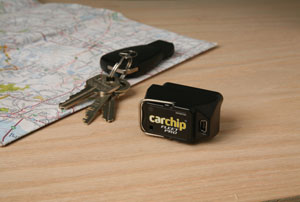
Technology is helping Encana employees who spend hours on the road as a part of their daily work, drive with more care.
“Encana has been trying to enhance their safety culture over the last few years. We corporately brought in our distracted driver policy. In the Clearwater Business Unit we also thought we would try to enhance our driving behaviours,” said John Christoffersen, Team Lead, Operations, Facilities Engineering and Pipeline Construction for the Clearwater Business Unit.
They piloted the project for about six months and as of January, about 150 fleet vehicles in the Chinook Business Unit have been fitted with the CarChip.
“We thought it was the best tool for enhancing our driving behaviours, and at the same time enhance the safety on the roads, not only for our people, but for everyone who uses the roads,” said Christoffersen.
The device allows the company to set parameters for driving habits. At Encana, they have the chips programmed to monitor speeding, hard braking and hard acceleration. If the driver approaches one of the set limits, the device will beep, giving the driver immediate feedback, allowing them to correct the behaviour.
“It gives instantaneous feedback and that really helps to raise the driver's awareness of what he is doing,” said Christoffersen. “In the oilfield, probably one of the highest risk things a person does is drive. Sometimes complacency can set in; you are thinking of what you have to do or something else… If you are distracted a bit and do start speeding up, you get the feedback right away.”
Not only is there feedback the instant the event happens, but the information can also be downloaded and monitored. Monthly reports are made of the incidents.
“What it does is put out a score card of how people have done,” said Christoffersen.
He said drivers could be disciplined if there is a pattern of a driver continually being in the red.
“Before we started the program, about 20 per cent of the people were in the red…within a couple months we were down to about five per cent, and another couple of months we were down to two per cent,” he said. “Now we're are almost a year into the program and we may see one person in the red once in awhile.
Christoffersen said at first some of the drivers were a little hesitant to try out the new technology, but now don’t seem to have a problem with it.
Craig Thatcher, production technologist with the Clearwater Business Unit has used the technology and said it does change habits for the better.
“It is really amazing to see …when you make that same drive day after day, you sort of fall into a routine and your mind can sometimes wander a bit, and the chip is really good to bring yourself back to the most important task at hand which is driving,” said Thatcher. “Something we do everyday, which is considered the most dangerous thing we do, our full focus should be on the task at hand.”
He adds the habits he has built driving with the chip have affected his driving habits when he is not in a fleet vehicle, but in his own private vehicle.
Christoffersen said while it's difficult to make a correlation, less than a year into the program, there has been a trend showing less accidents.
“It is premature to say it is because of the CarChip, but we have noticed our incidents in 2010 are probably close to half of what they were in 2009,” he said.
“We do feel the CarChip has made a significant impact on our incidents just because awareness and driving behaviors have changed,” said Christoffersen. “We weren’t unsafe drivers, but sometimes you need a reminder, that's what it is there for.”